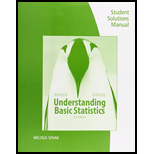
For Problems 7-21. please provide the following information.
(a) What is the level of significance? State the null and alternate hypotheses.
(b)Check Requirements What sampling distribution will you use? Do you think the sample size is sufficiently large? Explain. Compute the value of the sample test statistic and corresponding z value.
(c) Find the P-v alue of the lest statistic. Sketch the sampling distribution and show the area corresponding to the P-value.
(d) Based on your answers in parts (a) to (c). will you reject or fail to reject the null hypothesis? Are the data statistically significant at level
(e)Interpret your conclusion in the context of the application.
Plato’s Republic: Syllable Patterns Prose rhythm is characterized by the occurrence of five-syllable sequences in long passages of text. This characterization may be used to assess the similarity among passages of text and sometimes the identity of authors. The following information is based on an article by D. Wishart and S. V. Leach appearing in Computer Studies of the Humanities and Verbal Behavior (Vol. 3, pp. 90-99). Syllables were categorized as long or short. On analyzing Plato’s Republic, Wishart and Leach found that about
Trending nowThis is a popular solution!

Chapter 9 Solutions
Student Solutions Manual for Brase/Brase's Understanding Basic Statistics, 7th
- Find the critical value for a left-tailed test using the F distribution with a 0.025, degrees of freedom in the numerator=12, and degrees of freedom in the denominator = 50. A portion of the table of critical values of the F-distribution is provided. Click the icon to view the partial table of critical values of the F-distribution. What is the critical value? (Round to two decimal places as needed.)arrow_forwardA retail store manager claims that the average daily sales of the store are $1,500. You aim to test whether the actual average daily sales differ significantly from this claimed value. You can provide your answer by inserting a text box and the answer must include: Null hypothesis, Alternative hypothesis, Show answer (output table/summary table), and Conclusion based on the P value. Showing the calculation is a must. If calculation is missing,so please provide a step by step on the answers Numerical answers in the yellow cellsarrow_forwardShow all workarrow_forward
- Show all workarrow_forwardplease find the answers for the yellows boxes using the information and the picture belowarrow_forwardA marketing agency wants to determine whether different advertising platforms generate significantly different levels of customer engagement. The agency measures the average number of daily clicks on ads for three platforms: Social Media, Search Engines, and Email Campaigns. The agency collects data on daily clicks for each platform over a 10-day period and wants to test whether there is a statistically significant difference in the mean number of daily clicks among these platforms. Conduct ANOVA test. You can provide your answer by inserting a text box and the answer must include: also please provide a step by on getting the answers in excel Null hypothesis, Alternative hypothesis, Show answer (output table/summary table), and Conclusion based on the P value.arrow_forward
 College Algebra (MindTap Course List)AlgebraISBN:9781305652231Author:R. David Gustafson, Jeff HughesPublisher:Cengage Learning
College Algebra (MindTap Course List)AlgebraISBN:9781305652231Author:R. David Gustafson, Jeff HughesPublisher:Cengage Learning Glencoe Algebra 1, Student Edition, 9780079039897...AlgebraISBN:9780079039897Author:CarterPublisher:McGraw Hill
Glencoe Algebra 1, Student Edition, 9780079039897...AlgebraISBN:9780079039897Author:CarterPublisher:McGraw Hill

